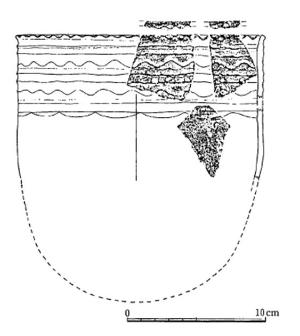Last updated: October 29, 2018
Early Jomon period earthenware and stone tools
With the construction of Komazawa Gakuen, an excavation survey of six ruins located within the school grounds was carried out from 1981 to 1982. The ruins are located on the hillside of Sakahama and are a complex of ruins spanning from the Jomon period to the Heian period to the Edo period. The center of the ruins dates back to the Jomon period, and includes three pit dwellings from the early and middle periods, as well as the ruins of a cooking facility made from stones. Fifty-seven tunnels and six pits and earthen pits for hunting were discovered. As remains of particular interest, the early Jomon period and early relics concentration area were discovered from a point on the east side of the ruins. Eight pieces of earthenware and stone tools excavated there have been designated as Inagi City's tangible cultural properties. Among them, Biryukisen Mondoki, which was created approximately 12,000 years ago, attracted attention as the oldest Jomon pottery in Inagi City.
We will introduce earthenware (doki) and stoneware (seki) from the early days. The pottery is called Biryukisen Mondoki, and is thought to have been made about 12,000 years ago. It is composed of three fragments of the mouth and body, and is characterized by the addition of straight and wavy thin ridges. When the entire piece of earthenware with a slight ridge pattern is reconstructed, it measures approximately 18.3 centimeters in diameter and 20 centimeters in height, and is a deep pot-shaped pot with a round bottom. It is estimated that (see the figure below). The stone tools date from the same period as the above-mentioned pottery with a slight ridge pattern, and a total of four pieces that appear to be hunting tools were unearthed. The two items are hunting tools that were characteristic of the early days, called sharp-pointed tools. It is a pointed stone tool with a barb shaped like a tongue at the base. One item is a pointed tool, which is slender and has a serrated edge on both sides. Although it lacks a base, it may become a lingual point with a tongue. Another item is wedge-shaped stone tools. Stone tools were excavated from the Paleolithic period to the Jomon period. It is thought to be from the same period as Kisen Mondoki). The cross section is triangular pyramid shaped.

Restoration drawing of earthenware with fine ridge line design
Three pieces of pottery from the early and middle Jomon period were excavated from the stone collection site (place where stones were collected for cooking, etc.) at the same spot. did. One item is deep pot-shaped earthenware (Fukabachi-gatadoki) from the early Jomon period. It is approximately 24 cm in height and 17 cm in diameter. It has a pattern similar to ropes on its entire surface, and has a simple structure with few decorations, which is typical of the earlier period. The rest are pottery from the middle of the Jomon period, made mainly in Chiba and Ibaraki prefectures, but are thought to have been brought to Inagi through trade. One item is a deep pot-shaped pottery, which is a large pottery approximately 40 centimeters in height and 28 centimeters in diameter. There are four handles on the rim of the pot, and a pattern is created by pasting clay in a line from above the pot. The other piece is also a deep pot-shaped earthenware pottery, measuring 27 centimeters in height and 22 centimeters in diameter. There is a similar raised band pattern on the rim of the mouth.
Inagi City Education Department Lifelong Learning Division Tel: 042-377-2121